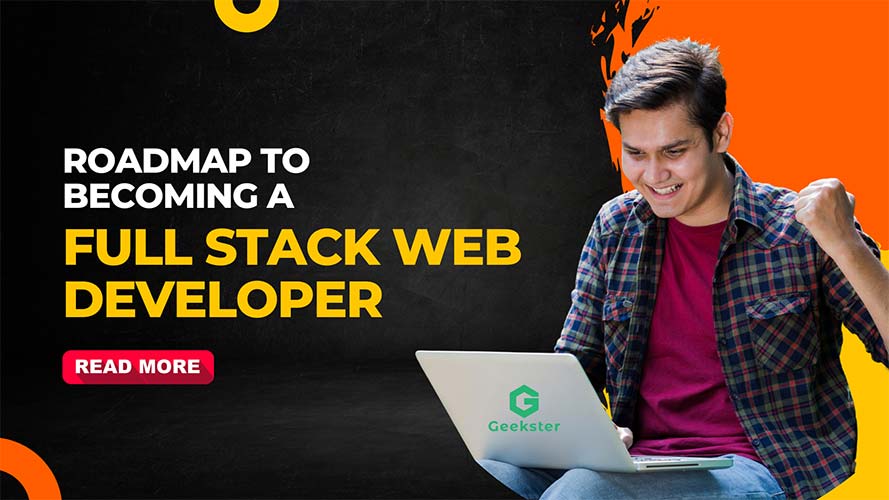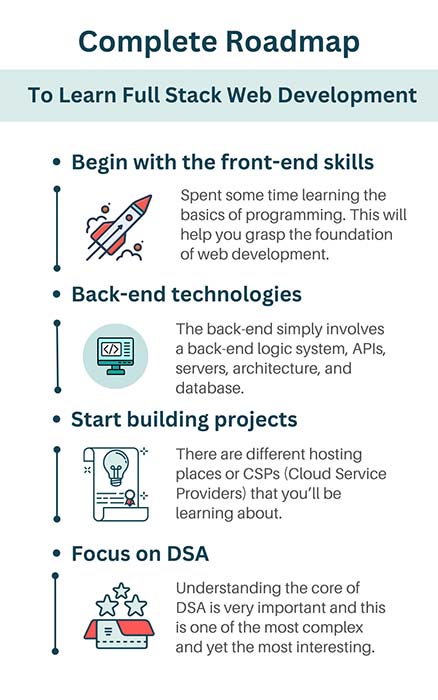The past two decades have proven to be a boon for web developers. Everything from a tiny needle to SpaceX’s giant Falcon 9 is having a strong digital presence; this has resulted in a huge demand for web developers. Not only is the job demanding, but it is also high-paying. If you have excellent command over full-stack web development, you can easily grab a prestigious job in the market. But becoming a full-stack developer is not easy; it comes with heaps of challenges. We understand the pain and thus reveal to you an 8-month roadmap to learn full-stack web development.
This roadmap will be focusing on taking on the front-end as the very gateway toward the full-stack. Depending upon your interest, you may choose the back-end as well. If you are planning to take some full stack web developer courses, then you might also be suggested some other paths. Numerous roads lead to the same summit called full-stack developer. Here is a brief into what you will learn during the entire course of your full stack roadmap:
- Front-end
- Back-end
- Database – SQL and NoSQL
- VCS
- DSA
1. Begin with the basics- front-end skills
Spent some time learning the basics of programming. This will help you grasp the foundation of computer and web development, learn about the internet (DNS, HTTPS, etc.), and provide you with the padding for further impact. This will also be the time when you’ll start smelling the basics of front-end web development. You’ll be focusing on the front-end basics – CSS, HTML, and JavaScript. These are the basic building blocks of the main UI that the viewers see. CSS is considered by many as the language they could learn while grooving in the Tomorrowland festival. The syntax is simple, the rules are basic, and the process is simple. You will start developing things after a week of learning.
HTML is a markup language that is used to format the webpage and provide it with a structure. JavaScript is a scripting language that is used to provide interactivity and overall creativity to the page. Javascript provides functionalities to front-end elements
2. Practise your front-end skills
This is the time to put your HTML and CSS into practice. Don’t try to create a professional working website otherwise, you will end up getting disappointed. Instead begin simple and small. For example, build a personal website, or an email newsletter, create animations, or a form. These will help you understand the application of each feature.
Once you have successfully done this, add functional elements using Javascript. Take this step by step instead of jumping to create a website.
3. It’s time to buckle up for Back-end technologies
Now it is time to enter the world of Back-end development. The back-end simply involves a back-end logic system, APIs, servers, architecture, and database. Where the front end takes care of the UI, the back-end takes care of the back-end logic (how a website functions when a user interacts with it). A back-end developer knows backend technology and DB. A database is where all the data is stored and retrieved. Different full stack web developer courses may curate different paths for you as per your interest. So, don’t panic if you see a few changes here and there.
You learn Python, Java, PHP programming languages. You don’t have to learn all of them together but you must master one of them.
Start learning Node.JS and MongoDB. DBs are of two types – SQL (in table form) and NoSQL (not in table form). MongoDB is a NoSQL. Also, you should learn Python and start working on Django + SQLlite.
Version Control: Learn Version Control System. It will help you learn how to host your projects on VCS websites. It will allow you to publish your content online. Git and GitHub are the most popular and widely used VCS.
4. Start building projects
Till this point, you must’ve learned about Front-end, Back-end basics, and Database technology. Now, you should start taking on full-stack projects. There are different hosting places or CSPs (Cloud Service Providers) that you’ll be learning about. CSPs like AWS, Azure, DO, GCP, etc. host everything that is developed. Learning about these is important.
Start cloning a few famous websites, build your own portfolio, and also explore Bootstrap. Bootstrap is a CSS framework that you can use to develop responsive websites and enhance their quality.
5. Move to frameworks, libraries, and Stacks
Till now, we focused on learning the basic skills required for full stack. Now, start with advanced front-end frameworks and libraries. There are a few libraries that are popular and you must learn for the front end like– React.js, Angular, Vue.js, Typescript, JQuery, etc.
For back-end you have Django, Lavarel, Ruby on Rails, etc
6. Choose a tech stack
A tech stack is basically a stack of technologies to create a complete website and contains front-end, and back-end technologies. This is where you start to become a full-stack developer. Some of the most common tech stacks are:
MERN: MongoDB, ExpressJS, ReactJS and NodeJS
MEAN: MongoDB, ExpressJS, AngularJS, and NodeJS
7. Focus on DSA
While you are all set to become a full-stack developer, you need to learn a few more things to become an exceptional one– Data Structure and Algorithm. Understanding the core of DSA is very important and this is one of the most complex and yet the most interesting part of programming. This includes how to organize data, how to deal with time and space complexities, etc.
While all this might sound overwhelming right now, it is achievable with the right guidance. It is crucial to choose best online coding course because that decides the path to your success ultimately. We highly recommend Geekster to learn coding online because of how deep they dive into building your core skills and imparting practical knowledge through projects. In case, you are looking for a structured course, check Geekster out. They have an 8-month course for full stack development with placement assistance. You must also do your own research to find the right fit for you and to get assured of how good Geekster is.
This is a very fruitful career with a good salary and high career growth. Hope this roadmap helps you give clarity on how to become a full stack developer.


1 Comment
Pingback: The Start-Up That’s Making Healthcare More Accessible To Corporate India